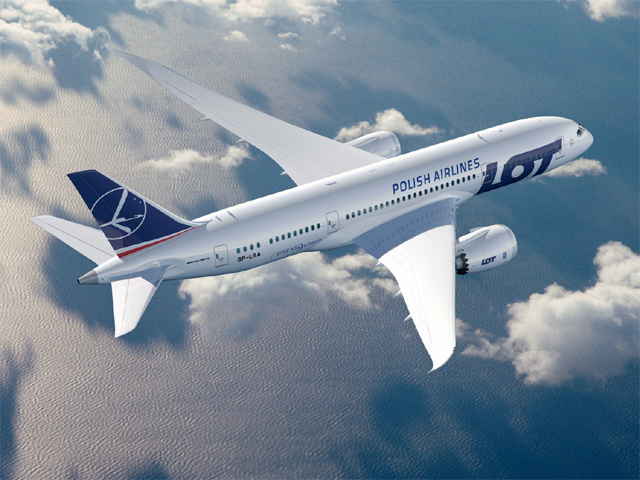
LOT's new livery to debut on the Boeing 787 Dreamliner. Photo courtesy of Boeing and LOT. Click for larger.
LOT Polish Airlines currently has eight Boeing 787 Dreamliners on order and during the Paris Air Show they unveiled an updated livery that will debut on the Dreamliner. The large “LOT” lettering and bird will remain, but with many other updated airline liveries, the cheat line running down the windows will disappear. The aircraft will be configured with 18 business class, 21 premium economy class and 213 economy class seats. LOT is set to be the first European airline to receive the 787 Dreamliner, starting in summer of 2012.
The new livery is cleaner than their current one and it is great they are keeping the large “LOT” at the front making the airline easily recognizable. The color red is a new addition to the livery and matches the red found on the Polish flag. I think I can say I actually like the new livery quite a LOT (heh).
Check out Flight Global’s story with additional mock-ups of LOT’s new interior for the 787 Dreamliner and a photo from LOT of the model concept and some drawings at Paris.
-
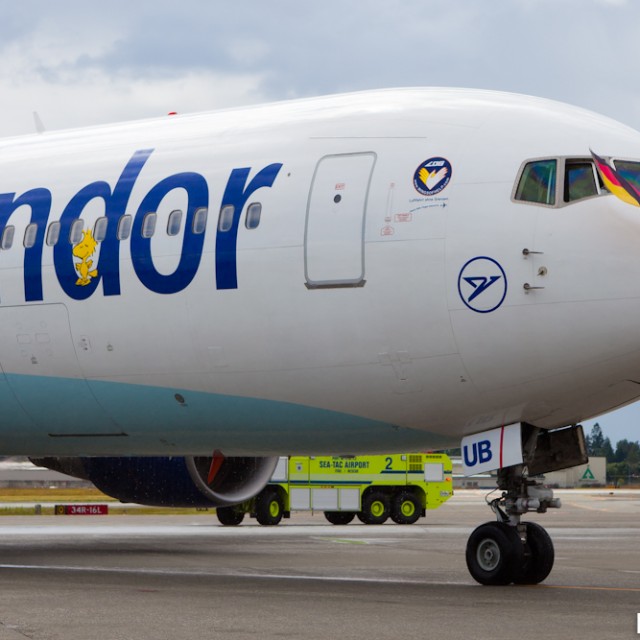
-
Condor’s Boeing 767-300ER (D-ABUB) arrives in Seattle with flags waving.
-
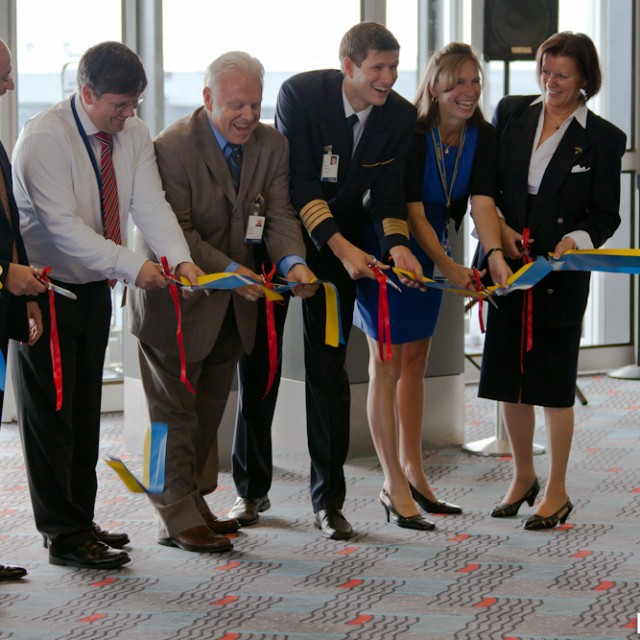
-
Ribbon cutting ceremony inside the terminal.
-
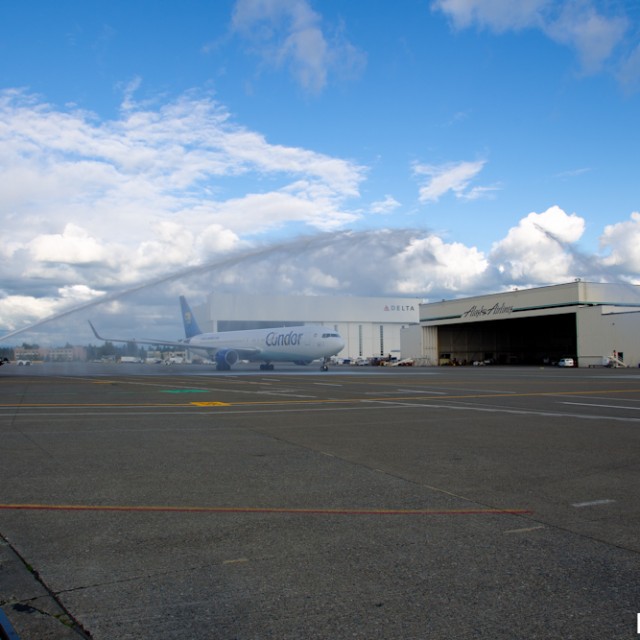
-
The 767 receives a water canon salute.
-
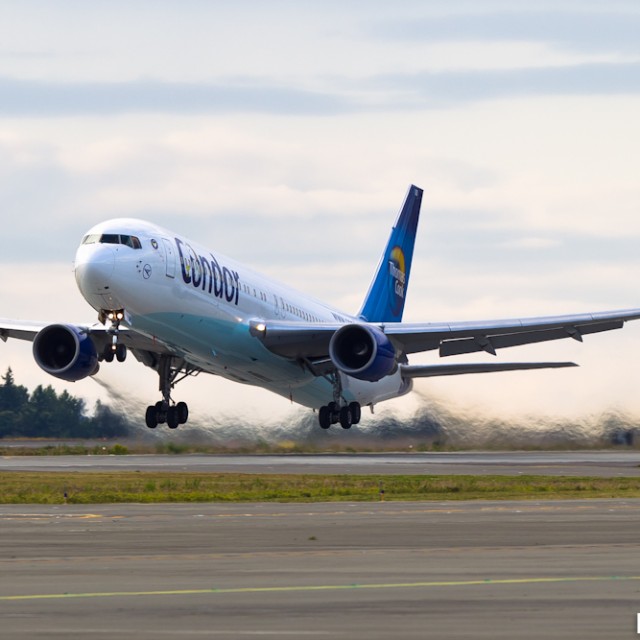
-
Condor’s 767 takes off for Frankfurt.
-
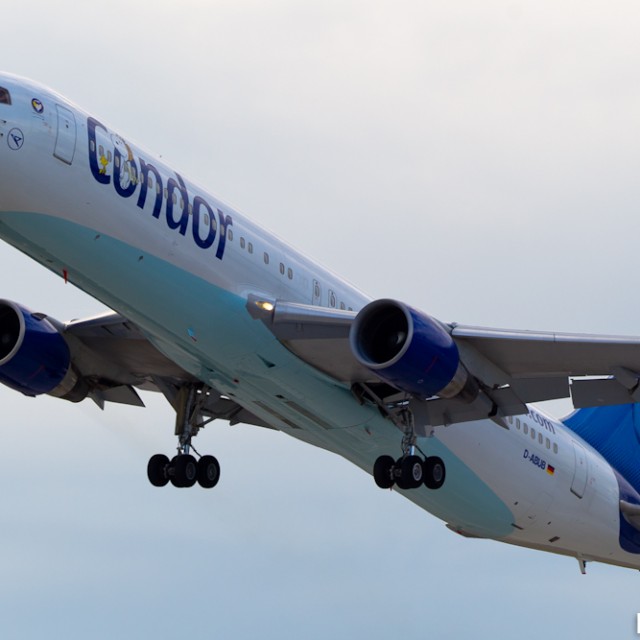
-
The blue-bellied aircraft lifts off from Seattle.
-
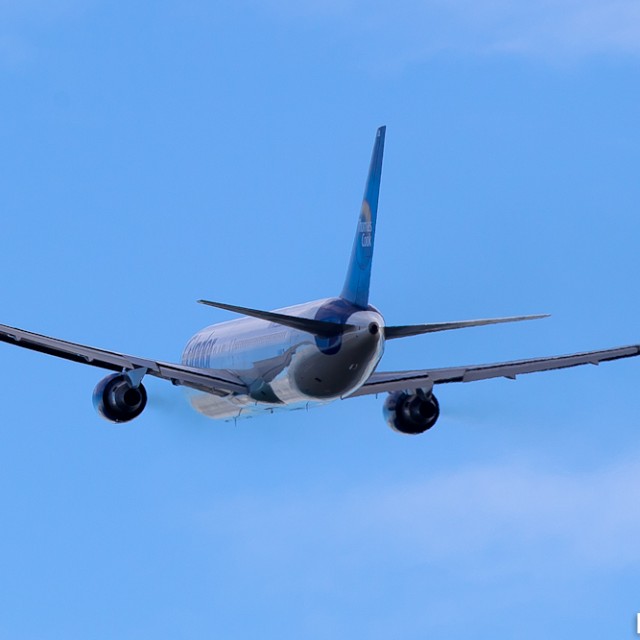
-
Onward to Germany.
All photos by David Lilienthal / NYCAviation.com – Click any for larger version
Condor Airlines, a low-frills airline based in Germany, commenced their first Seattle (SEA) to Frankfurt (FRA) flight yesterday using a Boeing 767-300ER (D-ABUB). The first flight, arrived about 4:00pm PST and was greeted by a water canon salute and a celebration at the South Terminal.
The new flight will commence twice per week and offer three classes of service: 18 seats in Comfort Class, 35 seats in Premium Economy (with 6 inches additional legroom) and 217 in economy. Condor will provide competition for Lufthansa who currently flies daily between Seattle and Frankfurt.
Seattle becomes Condor’s fifth destination in the US after Anchorage, Fairbanks, Fort Lauderdale and Las Vegas. Seattle has seen 6.7% increase in international traffic this year compared to 2010 and expects to see 23% more seats this summer to Europe versus last. Seattle currently operates flights to 19 foreign destinations that are served by 11 airlines.
’œThis new airline service will generate local jobs, provide more choices for travelers from Seattle to Europe, and provides capacity for air cargo between Seattle and Europe,’ said Mike Ehl, Director of Operations at Seattle Tacoma International Airport. ’œWe welcome Condor Airlines as part of our growth in international traffic.’
Condor Airline’s is Germany’s second largest airline and provides flights from Germany to mostly leisure destinations. The airline operates a fleet of 34 aircraft including the Boeing 757-300, Boeing 767-300ER and Airbus A320.
This story was a joint effort between AirlineReporter.com and NYCAviation.com
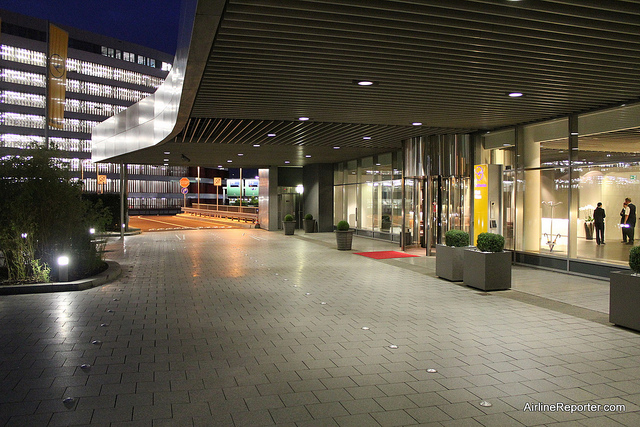
Lufthansa's first class terminal in Frankfurt is separate from the main airport.
There are many international airlines that have first class lounges, but not many who have a whole terminal just for passengers flying first class. Lufthansa’s First Class Terminal in Frankfurt, Germany is as about as exclusive as one can get flying scheduled airline service. This is not an area you can buy a day pass for and you won’t even have access if you upgrade to first class. You either have to pay full fare for your international first class ticket or you have to have HON circle status, meaning you fly 600,000 miles over a two year period. I recently had a special tour of the terminal and wanted to share the experience.

There are many areas inside the lounge to relax or do business.
Everything can be done for a passenger in the first class terminal — they even have their own security. The terminal is exclusive, but there are still about 200-300 passengers that will go through the lounge everyday. No worries, there are plenty of different spaces they can relax or do their business.

Want a drink? The Lufthansa bar has you covered.
The bar area has 86 different kinds of whiskey for customers. There also were a few jars of different candy (seen at the end of the bar) which added a nice touch.

Want to get some grub before your flight -- no problem. Although I probably wouldn't call it "grub."
Right next to the bar is an eating area, where guests can order and eat food for free. Well, they did have to pay for that first class ticket, but once you are inside the walls of the first class terminal food and drinks are on the house.
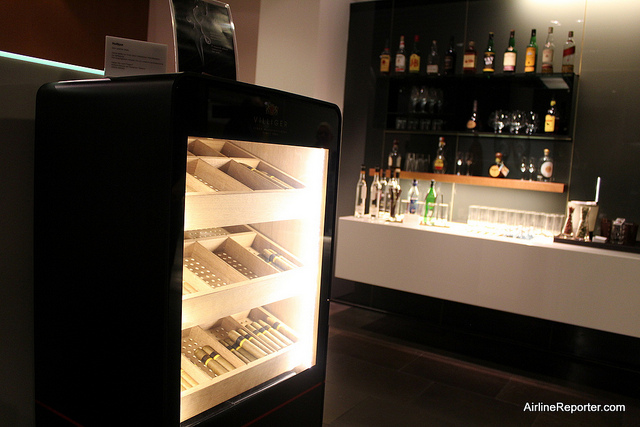
Cigar lounge and mini-bar. Hmm, don't see that in most clubs.
If the bar area becomes a bit too crowded for your taste, right across the hall is a cigar lounge with its own mini-bar. I wonder how many business deals have been done in this area.
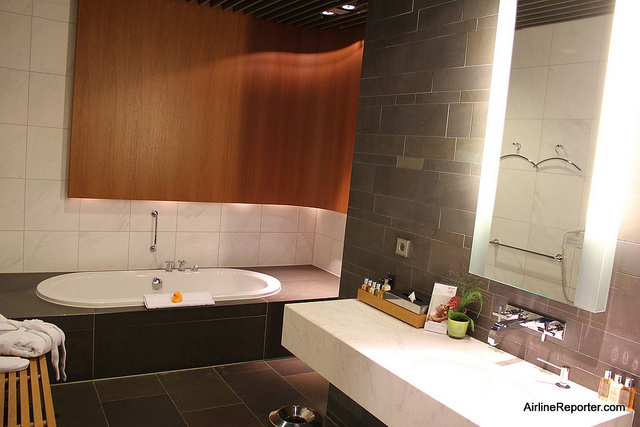
Eh, why take a shower when you can take a bath?
Many airline clubs are proud to state they have shower facilities available. Well, Lufthansa offers not only showers, but also full baths. And yes, that is a yellow rubber ducky on the edge of the bath and yes it has “Lufthansa” on it (photo) — now that is frek’n class.
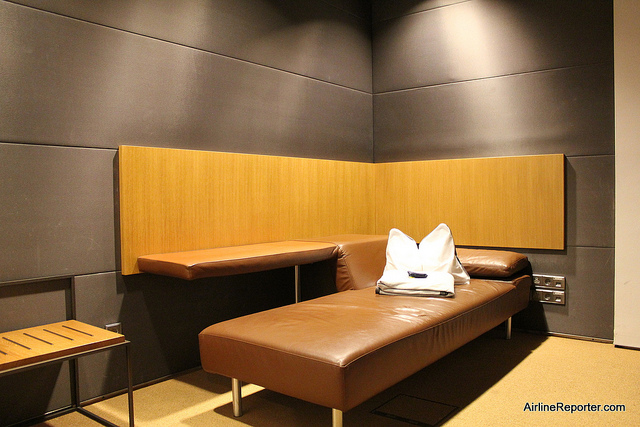
Want to get a little nap in during your layover -- no problem.
After having a few helpings of whiskey and finishing a cigar, one can get a little sleepy. Passengers are able to get a private room and catch a few z’s before their flight.
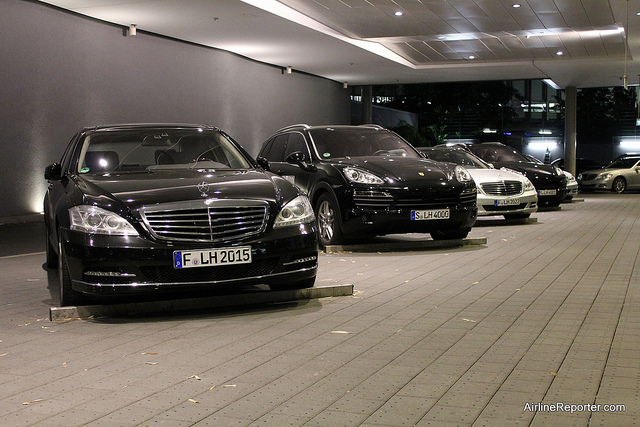
For someone who loves airlines and nice cars, this is the perfect blend.
Waiting at the gate, waiting for your row to be called is so for peons. When it is time to board your flight, someone will come get you and then you will be driven in either a Mercedes S500, Porsche Panamera or Porsche Cayenne. You will be chauffeured right to your plane where you can board to the first class cabin. That means you can make your own trip without even having to look at someone in business class, little alone economy. That is great for folks who want a little privacy.
For those select few who are able to use such an amenity, what a wonderful way to travel. For those who always say travelling is not what it used to be, this is a much better way to travel than it used to be, but it will just cost you a few bucks. For example, flying from New York to Frankfurt in Lufthansa first class will cost about $16,000.00 or Seattle to Frankfurt for about $20,000.00. But, of course if you have to ask how much it will cost, you probably can’t afford it.
VIEW A FEW MORE PHOTOS OF LUFTHANSA’S FIRST CLASS TERMINAL
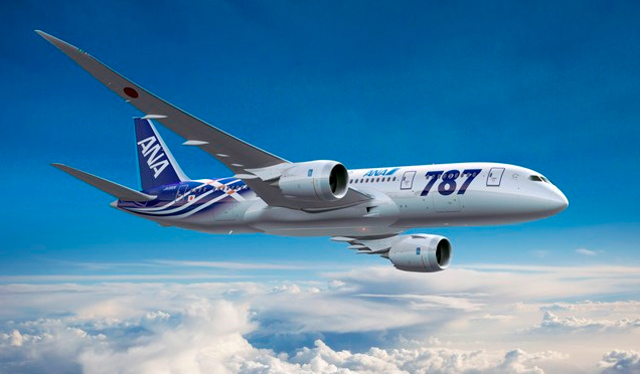
ANA showed off their special Dreamliner Livery today. Photo by Boeing.
Today, All Nippon Airways (ANA) unveiled their special Boeing 787 Dreamliner livery.
The livery is the celebrate that ANA will be the first airline in the world to fly the 787 Dreamliner. The blue lines at the rear of the fuselage are designed to highlight how the three core elements of the airline’s service brand – innovation, uniqueness and the inspiration of modern Japan ’“ operate across the ANA network. Only two Dreamliners will be painted in the special livery, the rest will be in standard ANA livery.
Many have assumed that ANA would create a special livery since two of their 787 Dreamliners parked at Paine Field have kept a blank livery. The above computer drawing is from Boeing, but ANA also released some images of what the livery will look like.
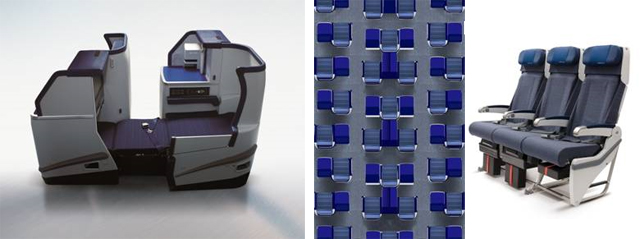
ANA's new Business Class will have staggered seating. Click for bigger.
ANA also unveiled their new cabin layout that will premier on the 787 Dreamliner. Business Class seats will have full lay flat beds, 17″ monitors and staggered seating, allowing aisle access from every seat. For both long and short haul layouts in the 787 Dreamliner, there will be two classes: Business and Economy.
Economy class will feature seats that have fixed backs, where a passenger can recline, but it will not impede into the person’s space behind you. Every seat will have in seat entertainment and universal power and USB ports.
ANA has ordered 55 787 Dreamliners and the first should be delivered sometime in August or September.
Randy Tinseth, vice president, marketing for Boeing Commercial Airplanes, also has some additional renderings on the ANA Boeing 787 Dreamliner livery and the interior configuration posted to his blog.
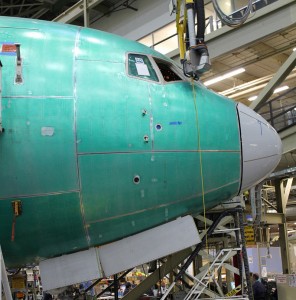
A brand is much more than the livery an airline decides to put on their planes.
Yesterday, Brett Snyder, on his blog Cranky Flier, wrote an interesting piece worth sharing on airlines, their fees and branding.
Airlines made $5.7billion in fees last year and it has caused many to feel airlines are ripping off the consumer to make big profits. Snyder looks at even with the fees, many airlines barely made any money last year. Then he explores why other large companies in the US can make way more profit, but do not get the harassment (or hatred) that airlines seem to receive.
Snyder hypothesizes that an airline’s brand can have a lot to do with perception and how consumers react to airlines. Could airline,s through advertising, set an unrealistic expectations for customers to have the best flight ever, yet get disappointed when reality hits?
There is a fine line. An airline should be able to state they offer a great service, but can an airline go too far with bringing up the ideals of the “way things used to be?”
It is a very solid perspective and definitely worth the read.

















